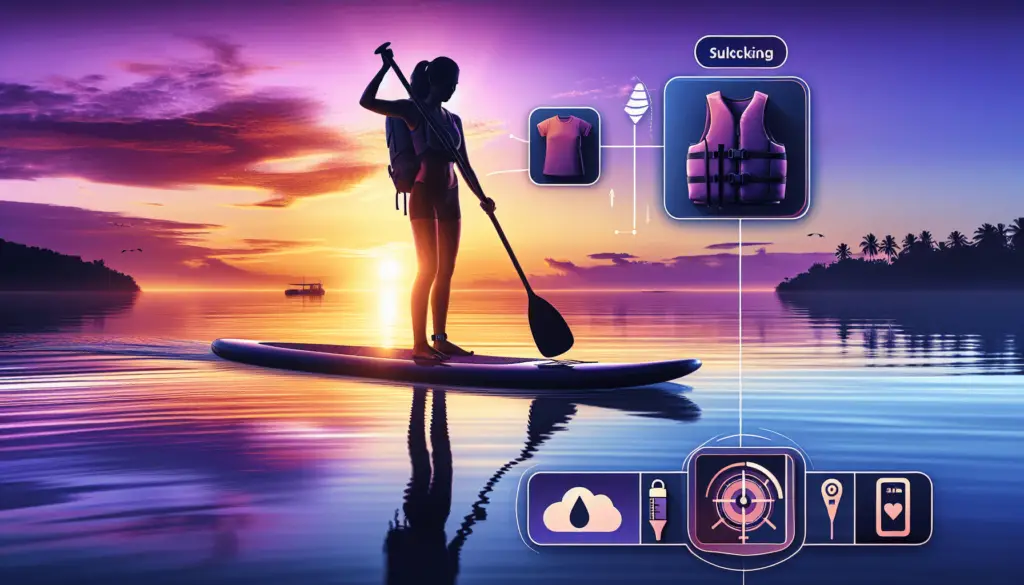Imagine yourself, a paddle slicing through mirrored waters, the slow rhythm of your kayak or paddleboard breaking the stillness of a beautiful morning. Your adventure on the water can be the perfect mixture of excitement and tranquility, or it can quickly turn into mishap if you’re not familiar with some fundamental safety precautions. In “Top Safety Tips for Paddleboarders and Kayakers,” you’ll find an invaluable guide filled with expert advice and practical techniques to ensure your every journey on the water is not only enjoyable, but also safe.

Understanding the basics of Paddleboarding and Kayaking
Being a newcomer in the realm of water sports can seem overwhelming at first, but fret not, for a thrilling adventure awaits you in paddleboarding and kayaking.
Learn to swim
Before embarking on your journey, you must learn how to swim. Swimming is your lifeline out there in deep waters, ensuring you can keep yourself afloat, even when confronted with unexpected mishaps. Strengthening your swimming skills not only enhances your confidence by the water but also equips you with the ability to navigate varying water currents.
Get a brief on basics of kayaking and paddleboarding
Next, familiarize yourself with the basics of kayaking and paddleboarding. Just as a painter equips himself with the knowledge of brushstrokes, knowing how to hold the paddle and manipulate it cleverly over waters, the balance required to stand or sit on the board or kayak, and mastering the art of steering, all form your initial chapter in this book of water adventures.
Understand how to manage the equipment
Lastly, learn to manage your equipment. This includes understanding how to carry, set-up, store, and mend your kayak or paddleboard. Equip yourself with knowledge about securing flotation devices and wearing helmets. Your equipment is your pal in this journey, and understanding how to manage it ensures you do not face a hurdle in your adventure.
Importance of Having the Right Equipment
Venturing onto water is like dancing in a ballroom. Just as a dancer’s shoes matter, so does your equipment.
Choosing correct paddleboard or kayak
Choosing the perfect paddleboard or kayak is vital. Consider factors such as size, weight, type, and construction material while selecting. This choice should cater to your fitness level, purpose, and water conditions.
Importance of personal floatation devices
Don’t underestimate the importance of personal flotation devices. No matter how strong a swimmer you are, a life jacket is your guardian angel on water. It keeps you afloat if exhaustion kicks in, or when unexpected situations arise.
Helmet requirements based on water conditions
Similarly, the helmet shields your head from sudden impacts. Depending on the water’s ferocity, its presence might be a necessary inclusion in your gear. Tranquil waters might not call for it, but during venturing rapid waves or kayak surfing, it becomes indispensable.
Using wetsuits and drysuits for thermal protection
Lastly, wetsuits and drysuits are your thermal insulators. Water and weather conditions significantly impact your body temperature. Counter this by wearing thermal protection gear. Wetsuits are perfect for warmer waters, while drysuits are ideal for colder climates where they keep you dry and warm.
Checking Weather and Water Conditions
As adventurers, it is crucial you share a bond with the nature’s elements. One such manifestation involves understanding the weather and water conditions.
Understanding and interpreting local weather forecasts
Studying weather forecasts is critical. Be attentive to details about wind speed, direction, tides, and chances of storms. This awareness equips you to be better prepared.
Pay attention to sudden changes in weather
In as much as understanding weather patterns, keep an eye on sudden weather changes. Nature can often throw curveballs, and it’s your adaptability that can make or break your excursion.
Understanding water currents and tides
Equally important is comprehending the nuances of water currents and tides. Being in tune with water behavior allows you to navigate better and prevent unprecedented incidents.
Learning Correct Paddling Techniques
Even though paddleboarding and kayaking may appear simple, mastering the art of paddling requires special attention.
Getting professional training
Getting professional training ensures that you learn correct techniques, safety measures, and even unique tips and tricks. Learning under an expert ensures you grasp the essentials of the sport quickly and in a safe, controlled way.
Practicing different paddle strokes
Understanding and practicing different paddle strokes are analogous to learning different dance steps. The stroke you use is largely based on whether you want to turn, reverse, or paddle forward. Practicing a variety of strokes provides you flexibility and maneuverability on water.
Learning techniques to manage strong winds and waves
Lastly, learn the techniques to tread strong winds and waves. These can be your toughest tests, but with training and experience, even these can be tackled with ease.

Keeping Track of Your Location
Exploring water bodies can sometimes lead one astray. Thus, navigation is key.
Using navigation aids effectively
Whether it’s a compass, GPS, or satellite communicator, learn to use them effectively. These aides are your roadmaps in the vast ocean or when in unfamiliar territory, helping you avoid getting lost.
Understanding waterway signals and markers
In addition to this, learn to comprehend waterway signals and markers. These are the language of the waterways, guiding the way and warning of potential dangers.
Carrying location identification and communication tools
Carry your identification at all times and equip yourself with communication tools. In case of need, you are easily trackable and can reach out for assistance.
Importance of Being Physically and Mentally Prepared
Paddleboarding and kayaking are as much a mental exercise as they are physical.
Physical conditioning for paddling
These sports require you to be in good physical shape. Core strength, balance, and cardiovascular health are vital. Regular exercising, practicing yoga, and being active overall prepare you for the physical exertion on the water.
Managing exhaustion and hypothermia
Adventure comes with its trials. Being aware of your physical limits and learning to manage potential hazards like exhaustion and hypothermia are essential. Resting periods, hydration, wearing appropriate gear, or even taking breaks when needed can help manage these situations.
Understanding stress and fear management techniques
As crucial as physical conditioning, mentally preparing yourself fosters agility and resilience. Understanding stress and fear management techniques aids in remaining calm and composed when the waters get wild or when situations become challenging.
Knowing the Rules of the Water
Just as roadways, waterways have their rules too.
Understanding right of way rules
Knowing the right of way rules prevent collisions and misunderstandings on water. For instance, understanding when to give way to others based on their vessel type or based on their direction of approach is crucial.
Learning international communication and signal codes
Equip yourself with international communication and signal codes. These are universally recognized systems aiding in seamless communication on water, especially in case of any unforeseen emergencies.
Knowing local and national boating laws
Last, but never least, familiarize yourself with local and national boating laws. Complying with these ensures smooth and lawful voyages.
Valuing Group Paddling and Buddy System
Navigating waters can be a wholesome experience when shared with others.
Benefits of paddling in a group
Paddling in a group enhances your learning curve, gives an added layer of safety, and most importantly, makes the journey more memorable.
Understanding the buddy system and its importance
The ‘buddy system’, where you pair up with another person, is a practical safety measure on the water. The pair constantly checks on each other, immediately raising alarms if anything seems amiss.
How to communicate effectively within the group
Learning to communicate effectively within the group ensures safety and connectivity while away at sea. Decide upon visual signals or whistle codes that the group understands and can use when out of verbal communication range.
Preventing and Managing Capsizes
Capsizing can be daunting, but with careful preparation, its intensity can be managed.
Learning self-rescue techniques
Equip yourself with self-rescue techniques that you can use if you find yourself toppled into the water. Learning to turn your kayak or paddleboard upright, and climbing back onto it, makes you resilient in the face of situations like these.
Practicing buddy-rescue strategies
Likewise, learn buddy-rescue strategies. This develops teamwork and supports your buddy if they encounter trouble.
Dealing with undercurrent and avoiding foot entrapment
Lastly, understand how to deal with an undercurrent where getting trapped is a possibility. Learning how to extricate from tangled seaweeds or when your foot gets entrapped ensures you aren’t caught unprepared.
Importance of Care For The Environment
When indulging in these adventure sports, don’t forget that the environment is granting you this experience.
Understanding ‘Leave No Trace’ Principles
Practice the ‘Leave No Trace’ principles, which insists upon respect for wildlife, minimizing impact, and importantly, carrying out whatever you bring in.
Managing waste responsibly
Manage your waste responsibly. If you are carrying food and drinks, ensure you do not accidentally litter the water bodies. Aim to keep our waterways as pristine as we found them.
Understanding potential impact on wildlife and habitats
Lastly, appreciate and respect the biodiversity you encounter. Do not disturb the habitats and refrain from touching, feeding, or harassing aquatic life. This ensures that the beautiful relationship between humanity and nature continues to flourish.
These Top Safety Tips for Paddleboarders and Kayakers only form the backbone of your experience. Each voyage teaches you something new. Embrace those learnings and let them guide you in this fascinating journey on water.

